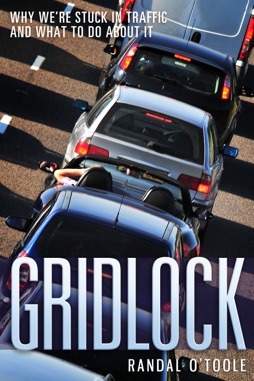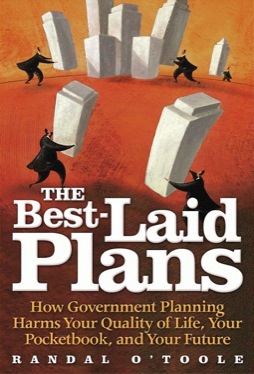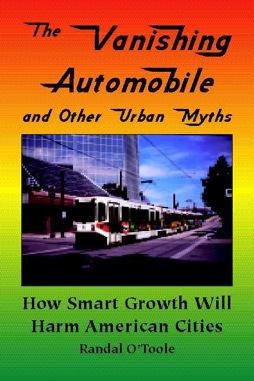The news from California this week is that Michael Hursh, the CEO of the Alameda-Contra Costa Transit District (AC Transit), is resigning, but the agency will continue to pay him through September as a “senior advisor.” The real news is how much he was paid: according to Transparent California, in 2022 he collected $556,045.
Former AC Transit CEO Michael Hursh and current AC Transit board member Sarah Syed. Photos by AC Transit.
Transit agencies have historically paid their executives well, but $556,000 seems like a lot even for these agencies. So I decided to do a quick survey of transit agency executive pay. First, Hursh’s resignation is worth examining in a little more detail.
Hursh had been chief operations officer for the Santa Clara Valley Transportation Authority (which I’ve long considered to be one of the worst-managed transit agencies in the country) when AC Transit picked him to be its CEO in September 2015. Contrary to news reports, his salary is not $566,045; his base salary was $278,255 in 2022, but he also received $144,950 in “other pay.” This other pay is probably mostly bonuses but may include “allowances” for housing and personal motor vehicles. )Transit agencies don’t expect their CEOs to ever actually ride transit except for show so they give them extra money to buy BMWs and Mercedes cars.) In addition, AC Transit contributed $132,840 to Hursh’s pension and health insurance. If that sounds like a lot, it is; as shown in the table below, no other CEO of a major California transit agency earned as much in either benefits or “other” pay.
While 2023 pay data aren’t available, Hursh’s career took a turn for the worse in that year when Sarah Syed took office on the AC Transit board. Syed works as a Transportation Equity Manager at the University of California, Berkeley, and when she closely examined AC Transit she found evidence of racism, sexism, and hostile work environments. She didn’t accuse Hursh personally of any of these problems, but instead of promising to try to fix them, Hursh accused her of bullying and harassment.
In a closed-door meeting that Syed alleged violated California’s open meetings law, the board agreed to pay Hursh through September if he would step down. September was chosen because that would make him eligible for a lucrative pension that requires ten years of employment. Despite press reports, AC Transit will probably not pay Hursh $556,045 but instead will give him his base pay of $278,255 (plus, no doubt, cost-of-living increases) as well as continue to pay into his pension and health care. In other words, he will get something north of $300,000 for nine months of not working.
| Agency | Year | Base Pay | Other Pay | Benefits | Total | 2019 Riders Millions |
|---|---|---|---|---|---|---|
| LA Metro | 2023 | 456,482 | 19,800 | 112,577 | 588,859 | 380 |
| AC Transit | 2022 | 278,255 | 144,950 | 132,840 | 556,045 | 54 |
| SF BART | 2022 | 402,951 | 41,044 | 91,345 | 535,340 | 128 |
| Santa Clara VTA | 2023 | 371,247 | 1,841 | 129,594 | 502,682 | 36 |
| Sacto RTS | 2020 | 315,133 | 65,360 | 87,315 | 467,808 | 20 |
| SamTrans | 2023 | 350,000 | 0 | 107,571 | 457,571 | 11 |
| SMART | 2023 | 327,137 | 47,567 | 75,201 | 449,905 | 1 |
| San Diego MTS | 2023 | 349,522 | 3,402 | 96,013 | 448,937 | 85 |
| SF Muni | 2023 | 326,501 | 0 | 102,634 | 429,135 | 128 |
| Golden Empire | 2023 | 300,765 | 10,967 | 55,621 | 367,353 | 6 |
| Riverside County | 2023 | 283,358 | 29,749 | 48,850 | 361,957 | 9 |
| Marin County | 2023 | 249,122 | 0 | 58,402 | 307,524 | 3 |
Hursh’s base pay of $278,255 actually seems low when compared with other California transit agencies. While AC transit carried 54 million riders in 2019, Riverside Transit carried only 8 million, yet its CEO’s base pay was almost exactly the same as Hutch’s. (The number for Riverside is for 2023 while Hursh’s is 2022, so Hursh may have received a cost-of-living increase in 2023.)
Hursh’s total pay was $556,045 because he earned more “other pay” and “benefits” than any other transit agency CEO in California, and quite possibly more than any transit CEO in the country. Just what he did to deserve that pay and benefits is unclear.
Moreover, Hursh’s golden parachute is not unusual for transit executives. The CEO of Seattle’s Sound Transit, Julie Timms, is resigning due to “differences” between her and the board about “how to structure the agency.” (She claimed she was resigning to spend more time with her family but we all know that’s a dodge.) To ensure there are no hard feelings, the agency is giving her a full year of severance pay. Supposedly this is to provide “on-call services” as a consultant, but considering the differences it seems unlikely that the board will make use of those services.
According to GovSalaries, Timm’s 2023 compensation was $419,857. That would include any bonuses, housing allowances, and pension/health-care benefits, which aren’t broken down in GovSalaries’ database.
Probably due to California’s high cost of living, agency CEOs in other states don’t earn quite as much, but are still well compensated. According to a survey of transit agencies, the average CEO earned $177,170 in 2023, with 75 percent earning more than $128,000; half earning more than $160,000; and a quarter earning more than $210,000. CEOs of agencies with more than 1,500 employees earn an average of $316,000; those with 500 to 1,499 employees average $201,077; 200-499 average $184,750; and those whose agencies have under 200 employees average $154,027. These numbers probably include only base salaries and not bonuses or benefits.
| City | Agency | Pay | Source | 2019 Riders Millions |
|---|---|---|---|---|
| New York | MTA | 401,996 | GovSalaries | 3,451 |
| Chicago | CTA | 376,066 | Transit Talent | 456 |
| Boston | MBTA | 312,731 | GovSalaries | 367 |
| Philadelphia | SEPTA | 484,876 | GovSalaries | 308 |
| Atlanta | MARTA | 468,562 | Transit Talent | 118 |
| Denver | RTD | 315,000 | CBS News | 105 |
| Portland | TriMet | 415,530 | GovSalaries | 97 |
| Maryland | MTA | 349,773 | GovSalaries | 94 |
| Houston | Metro | 380,922 | GovSalaries | 90 |
| Twin Cities | Metro | 218,077 | GovSalaries | 78 |
| Dallas | DART | 346,611 | GovSalaries | 69 |
| Las Vegas | RTC | 349,061 | GovSalaries | 66 |
| Chicago | Metra | 325,825 | Transit Talent | 61 |
| Phoenix | Valley Metro | 344,750 | GovSalaries | 56 |
| Seattle | Sound Transit | 419,857 | GovSalaries | 48 |
| Salt Lake | UTA | 274,918 | GovSalaries | 45 |
| San Antonio | VIA | 423,498 | GovSalaries | 43 |
| St. Louis | Bi-State | 323,978 | GovSalaries | 37 |
| Chicago | PACE | 319,043 | Transit Talent | 29 |
| Columbus | Central Ohio | 363,825 | Columbus Dispatch | 19 |
| Honolulu | HART | 275,000 | GovSalaries | 1 |
Although CEOs of larger agencies tend to get paid more than those of smaller agencies, this isn’t a hard-and-fast rule. Houston’s Metro carries more than twice as many riders as San Antonio’s VIA, yet the former’s CEO gets 10 percent less pay. In fact, the head of New York’s MTA, the largest transit agency in the country, earns less than VIA’s CEO.
Washington Metro doesn’t appear to be in the GovSalaries database, but the agency says it pays its current CEO $485,000 a year with a potential 10 percent bonus plus pension and health insurance benefits.
One reason CEO pay is so high is that executives expect agencies expect to pay salaries competitive with “peer” transit agencies, and some even have that written into their contracts. Whenever one agency pays a little more than average, it pressures other agencies to raise their pay as well, leading to a vicious circle.
Many contracts also have automatic cost-of-living increases. The CEO of Atlanta’s MARTA gets a 5 percent increase each year. Since inflation has usually been around 2 percent, such CEO salaries grow much faster than the national average. Given competitive requirements, even if only one CEO has an automatic 5 percent adjustment, CEO pay would double every 14 years. In short, executive pay has very little to do with actual agency performance.
CEOs are not the only transit employees who earn a lot of money. The head of San Francisco BART earned more than $500,000 in 2022, but BART had 14 other employees who earned between $400,000 and $500,000 and more than 100 employees who earned between $300,000 and $400,000. In addition to Hursh, AC Transit had one other employee who earned more than $400,000 and 14 more who earned between $300,000 and $400,000.
CEOs aren’t always the highest-paid employees at transit agencies. The head of Boston’s MBTA earned $312,731 in 2023, but that made him only the ninth-highest paid employee in the agency. The highest, one Stephen O’Toole (whose name I mention only to add that he is no known relation to me), received $394,741 for his work as a “wireperson.” I presume that means he helps maintain the electrical systems that power many of Boston’s trains. Wage-earning employees such as O’Toole can earn a lot of money by working overtime. All but one of the other seven MBTA employees who earned more than the CEO were either maintenance workers or transit police.
In 2022, the median income for Americans who worked full-time throughout the year was $60,070, which was a slight decrease from 2021. While we would expect agency executives to be paid more than average, the salaries shown in the above tables are outrageous considering that transit is a failed industry whose customer revenues cover less than 15 percent of costs, whose long-term ridership is declining, and whose policies seem completely disinterested in fixing these problems. Indeed, it seems most likely that agency executives are paid more for their skills in wheedling money out of taxpayers than their ability to implement programs that carry out their missions of transporting more people.
Consider, for example, the Honolulu Authority for Rapid Transportation, which is building a 20-mile rail line that is expected to cost more than three times as much as the original projections. Its CEO made a relatively modest $275,000 in 2023, but in September the HART board increased her pay to $336,000. The part of the rail line that is open to date is barely carrying 1 million riders a year, but the board is more concerned with whether the agency can find enough money to complete the project than whether it actually carries any riders.
It’s time to bring a reckoning to the transit industry. If it isn’t completely eliminated as an obsolete artifact of a century ago, it should at least be reformed so that any subsidies that agencies receive are a function of the fare revenues they earn. This will make them responsive to the customers they serve rather than to the politicians who currently try to feed their bottomless appetites for tax dollars.









“Transportation Equity Manager” a useless, pointless waste of funds of any organization, particularly one that receives taxpayer dollars.